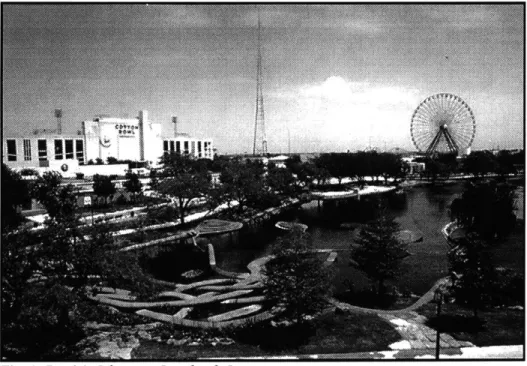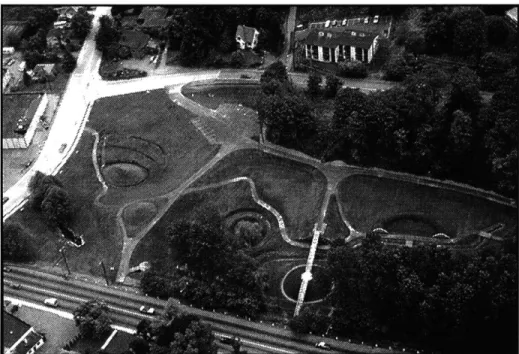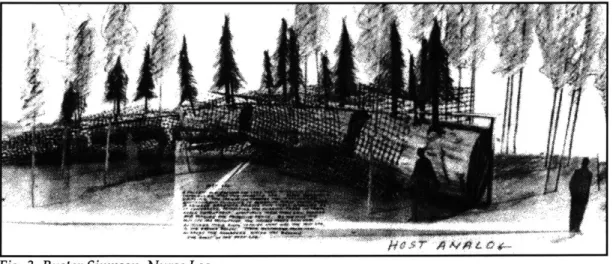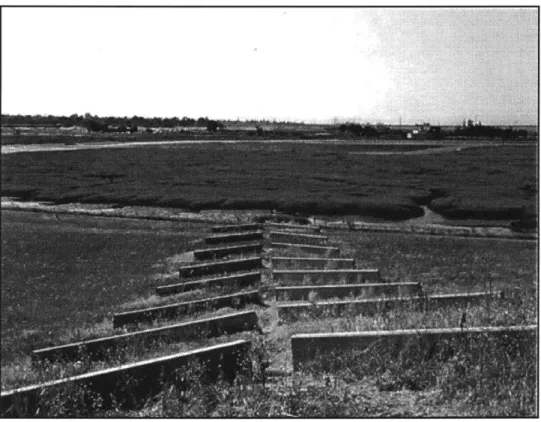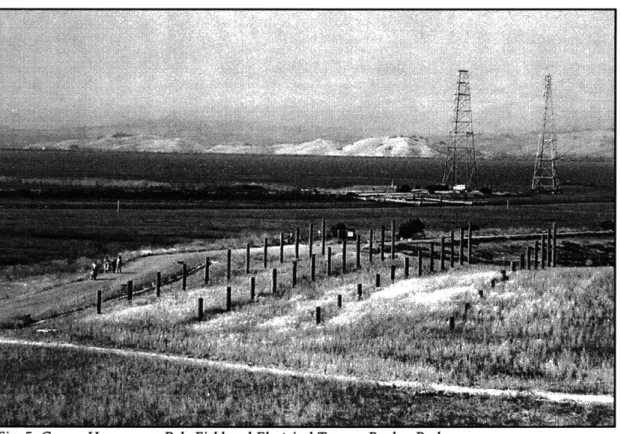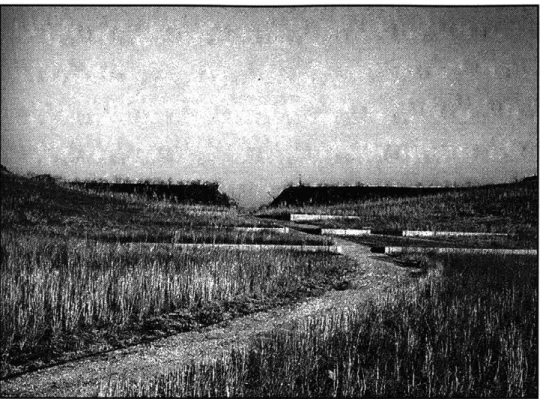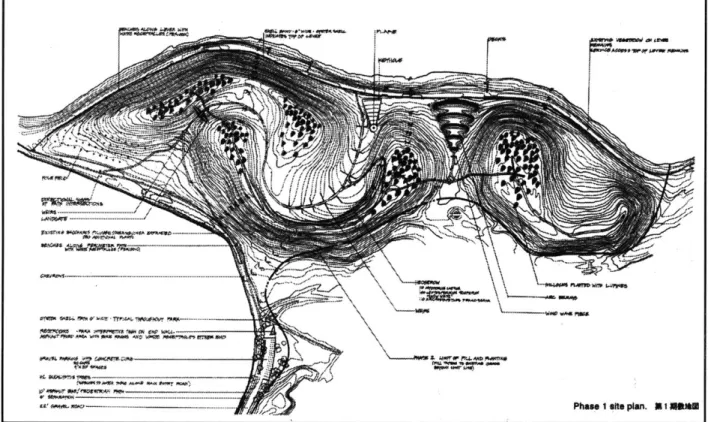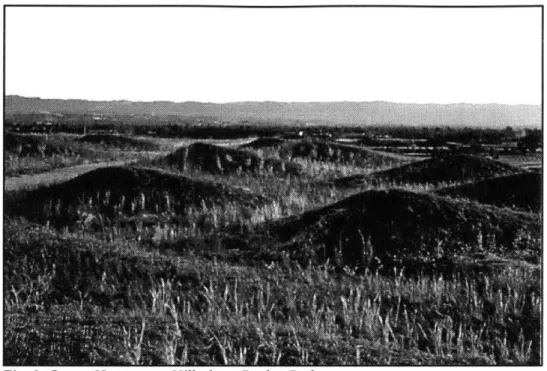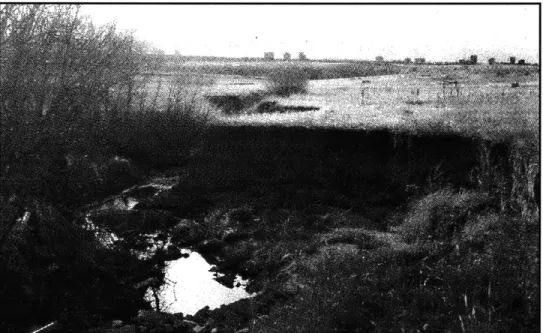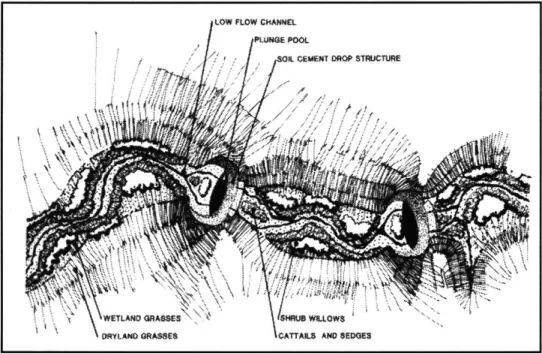Designing Change:
Transforming Cultural Attitudes Towards the Natural Environment
Through Design
by
Rebecca A. Lave
B.A. Art History and Political Philosophy
Reed College, 1993
Submitted to the Department of Urban Studies and Planning in partial
fulfillment of the requirements for the degree of
Master in City Planning
at the
Massachusetts Institute of Technology
June, 1997
@ 1997 Rebecca Lave. All rights reserved.
The author hereby grants to MIT permission to reproduceand to distribute publicly paper and electronic copies of this thesis in whole or in part.
Signature of Author:
Department of Urban Studies and Planning
May 22, 1997
Certified by:
e
/
-Kristina Hill
Assistant Professor of Urban Studies and Planning
Thesis Supervisor
Accepted by:
Mark Schuster
As ciate Professor of Urban Studies and Planning
Chairman, MCP Program
Designing Change: Transforming Cultural Attitudes Towards the
Natural Environment through Design
by Rebecca Lave
Submitted to the Department of Urban Studies and Planning on May 22, 1997 in Partial Fulfillment of the Requirements
for the Degree of Master in City Planning
Abstract
Over the last thirty years, for the most part independently of each other, public artists and landscape architects have begun to tackle environmental issues in their work. Whether by incorporating natural forces such as wind or tide into their designs,
'recreating' local plant communities destroyed by human intervention, or explicitly using their work to instruct about ecological processes and issues, these artists and architects have attempted to transform our attitudes about, awareness of, and behavior towards the natural world through design. To explore the strengths and weaknesses of these attempts at transformative environmental design, I focused on works by four designers: two landscape architects - George Hargreaves and William Wenk - and two public artists - Andy Goldsworthy and Alan Sonfist.
Based on my analysis, I argue that the most crucial problem facing environmental designers is the lack of a theoretical basis to support the social commitment of their work. More specifically, I argue that phenomenology and Jungian theory, the most common bases of landscape theory, are fundamentally unsuitable as frameworks within which to make culturally powerful design decisions because their most basic unit is the universalized individual. Instead, environmental designers must work from theoretical frameworks, such as social and cultural geography, that embrace the cultural aspects of landscape, and its concomitant potential to effect the values that shape it. Only then will designers be able to create landscapes that are transformative in any serious way.
Thesis Supervisor: Kristina Hill
This thesis is dedicated, in no particular order, to Peter Parshall, John Goldberg-Hiller, Peter Steinberger, and Ray Kierstead.
And to everyone at Reed
Table of Contents
Abstract 2
Dedication 3
List of Illustrations 5
Introduction: The Cultural Relevance of Landscape 6
Chapter One: The Goals of Environmental Design 11
The Public Park as Avante-Garde (Landscape) Architecture 17
Chapter Two: Focusing on the Individual 23
Byxbee Park - Hargreaves Associates 23
Shop Creek Park - William Wenk 31
A Collaboration with Nature - Andy Goldsworthy 37
Time Landscapes - Alan Sonfist 38
Chapter Three: A Critique of Contemporary Landscape Theory 53
Phenomenology: Husserl and Schutz 54
The Jungian Theory of Archetypes 55
Phenomenology and Jung in Landscape Theory 57
Weaknesses of these Approaches for Environmental Design 62
Cultural Geography and Landscape History 64
Conclusions: Future Directions 68
List of Illustrations
Figure 1: Patricia Johanson, Leonhardt Lagoon
Figure 2: Herbert Bayer, Mill Creek Canyon Earthworks Figure 3: Buster Simpson, Nurse Log
Figure 4: George Hargreaves, Chevrons at Byxbee Park
Figure 5: George Hargreaves, Pole Field and Electrical Towers, Byxbee Park Figure 6: George Hargreaves, Windgate and Weirs, Byxbee Park
Figure 7: George Hargreaves, Plan of Byxbee Park Figure 8: George Hargreaves, Hillocks at Byxbee Park Figure 9: William Wenk, Shop Creek Canyon Before Figure 10: William Wenk, Plan for Shop Creek Park Figure 11: William Wenk, Shop Creek Park
Figure 12: William Wenk, Drop Structure, Shop Creek Park Figure 13: Andy Goldsworthy, Sticks
Figure 14: Andy Goldsworthy, Oak leaves in holes
Figure 15: Andy Goldsworthy, Iris blades pinned together with thorns Figure 16: Andy Goldsworthy, Broken pebbles
Figure 17: Andy Goldsworthy, Balanced Stones Olive Trees
Figure 18: Alan Sonfist, Plan for Time Landscapes: Greenwich Village Figure 19: Alan Sonfist, Time Landscapes: Greenwich Village
Figure 20: Bonnie Sherk, Crossroads Community/The Farm Before Figure 21: Bonnie Sherk, Crossroads Community/The Farm
Figure 22: Lorna Jordan, Waterworks Gardens Site Plan
Figure 23: Lorna Jordan, The Entry Plaza at Waterworks Gardens Figure 24: Lorna Jordan, The Grotto at Waterworks Gardens
Introduction: The Cultural Relevance of Landscape
[Olur physical environment is a fundamental reflection of our culture. Today's parks and gardens, or the lack thereof, and the prevailing relations between build-ings and nature are perhaps the most visible reflection and symptoms of the pro-found ecological crisis on a global scale. Not only must we deal with the funda-mental ecological issues, but we must find new aesthetic and symbolic forms for our new faith in nature and the earth.1
- Stuart Wrede and William Howard Adams
-[W]hile our goal must be the sustenance of nature, our premise is the acceptance of the obvious artifice of human design, put to work by nature or for it.2
- Diana Balmori
-Over the last thirty years, for the most part independently of each other, a small number of public artists and landscape architects have begun to tackle environmental issues in their work. Whether by incorporating natural forces such as wind or tide into their designs, 'recreat-ing' local plant communities destroyed by human intervention, or explicitly using their work to instruct about ecological processes and issues, artists and landscape architects have attempted to transform our relationship with the natural world through design. Traditionally, these movements within landscape architecture and art have been regarded separately although they
address many of the same issues and use similar ranges of design strategies. The time is ripe to let go of disciplinary divisions and consider artists and landscape architects together in order to get a clearer picture of environmental design's strengths and weaknesses, and the unique challenges it faces.
Tackling environmental issues through landscape design is not an easy task for either landscape architects or artists. Neither existing design techniques privileging form over con-tent, nor traditional educational tactics will suffice. When designers attempt to use their work in transformative ways, they move away from both the single-mindedly aesthetic focus of much landscape design, and from the more explicitly didactic, often textual or narrative,
'Stuart Wrede and William Howard, eds., Denatured Visions: Landscape and Culture in the Twentieth Century
(H. N. Abrams, Museum of Modem Art: New York; 1991), p.6. 2
Diana Balmori, "Park Redefinitions," in Herbert Muschamp, et. al., Once and Future Park, (Walker
methods of informing the public used in environmental education. Instead, they rely on the visual/experiential power of their designs to convey their ideas, to catch and hold people's interest. Successful environmental design seems to demand both the environmental knowl-edge of the landscape architect and the interpretive skills of the artist, in addition to the flexibil-ity to discard many of both disciplines' traditional practices. In the struggle to find visual images and design experiences to transform our attitudes about, awareness of, and behavior
towards the environment, these works need to be considered together.
The first question that comes to mind in considering environmental design is why landscape should be considered a potential medium for transforming cultural attitudes. After all, landscape design has not been a particularly politically or socially engaged discipline in recent decades. But designed landscapes are in fact uniquely suited to carry messages about the natural world for at least three reasons.
First of all, for centuries parks, one of the most common forms of designed landscape, have been designed and viewed as imitations of nature, and thus continue to shape cultural ideas of what nature is.3 Secondly, public parks are widely accessible and well-used in this country, providing designers with an audience they could never get in a museum or publica-tion. Lastly, the designed landscape has traditionally been the site where our society negotiates the perceived boundary between nature and culture; this boundary must be redefined, per-haps even erased, in order to stop the escalating degradation of the natural environment.*
These issues are discussed at length in Herbert Muschamp's excellent edited volume,
Once and Future Park, where discussions of the future of public parks frequently revolve around
their potential to affect attitudes toward the environment. As he argues in his essay, "Looking Beyond Vision",
3Galen Cranz, The Politics of Park Design, (MIT Press: Cambridge, Massachusetts; 1982)
* In this thesis, I use "landscape" in the sense of cultural landscape; an environment shaped by humans, whether it be through agriculture or horticulture, clear-cutting or grading. "Landscape" encompasses
the land contained in a freeway clover leaf as well as the gardens at Versailles. For the most part, I will be discussing the designed landscape, environments shaped by architects, landscape architects and planners. Part of my argument, however, is that the designed landscape is strongest when it pulls from the cultural landscape around it.
The issue of the environment warrants special focus... [because of] the park's tradi-tional power to evoke imitations of nature. Many environmentalists insist that we should abandon our traditional binary distinctions between nature and culture. I believe that the urban park may provide the most readily available site for reconfiguring them.4
James Corner, John Dixon Hunt, and other scholars argue that historically, landscape had an even richer cultural role to play as both an embodiment and a creator of cultural values
stretching far beyond human relations to the environment. Corner, for example, writes that, Many fail to even appreciate the role that landscape architecture plays in the con-stitution and embodiment of culture, forgetful of the designed landscape's sym-bolic and revelatory powers, especially with regard to collective memory, cultural orientation, and continuity.'
There is some consensus that the designed landscape no longer holds such a central position in our society, that its metaphysical and meaningful content has been replaced within
the design professions by an emphasis on aesthetics alone. But some landscape historians and theorists are actively promoting a return to earlier, metaphysical principles of landscape design. Corner, especially, continues to regard landscape as a potential source of contemporary social meaning. Refusing to relegate culturally relevant landscape to the past, he argues that land-scape is still a repository of older meanings:
The landscape is itself a text that is open to interpretation and transformation. It is also a highly situated phenomenon in terms of space, time, and tradition and ex-ists as both the ground and geography of our heritage and change... Landscape is not only a physical phenomenon, but it is also a cultural schema, a conceptual filter through which our relationships to wilderness and nature can be understood....It is not until we choose a prospect and map what we see, marking some aspects, ignoring others, that the landscape acquires meaning... As time passes, this marked landscape weathers, ever subject to the contingencies of na-ture. Other points of view are chosen as circumstances change and new ways of marking are overlaid upon the old, producing colagic and weathered overlays. Residua in this topographic palimpsest provide loci for the remembrance, renewal, and transfiguration of a culture's relationship to the land.6
4Herbert Muschamp, "Looking Beyond Vision" in Herbert Muschamp, et. al., Once and Future
Park, (Walker Art Center: Minneapolis, MN; 1993), p.11.
5James Corner, "A Discourse on Theory II: Three Tyrannies of Contemporary Theory and the
Al-ternative of Hermeneutics," Landscape Journal, 10/2, (Fall 1991), p. 116. 6 lid p.129.
Corner is arguing, in effect, that the context for transformative design already exists; environ-mental designers need to use the cultural meanings latent in the landscape to reshape our relations to the natural environment.
It is important to note that this leads to a dramatically different vision of the appropriate social role of artists and landscape architects than the image of the solitary genius. In describ-ing environmental art in the catalogue for the 1992 exhibit Fragile Ecologies, Barbara Matilsky argues that environmental designers embrace this vision of the artist's instrumental involve-ment in society:
Through ecological artworks, artists try to mitigate environmental problems often by revitalizing an ecosystem and the human interaction with nature... Expanding upon early environmental art, these works represent a more socially oriented ap-proach to integrating art and nature... While restoring nature and the urban envi-ronment, artists also redefine their role in society. They become social activists, physically weaving their ideas into the fabric of a community?
Thus environmental designers go way past the elite audience of the gallery, attempting instead to rework widespread attitudes about the environment. The majority of the built landscape in America, after all has never been touched by designers. In his essay "The Ameri-can Ideology of Space," Leo Marx argues that most of the AmeriAmeri-can landscape has been created by just plain folks raised with the dominant American ideology of space (and its regulatory
manifestation: zoning). Notably utilitarian, this ideology has shaped the vast majority of the design decisions that make the sprawling, decentralized American landscape what it is today., He argues that it is thus absolutely crucial to rework this dominant ideology into a form more responsive to the needs of the natural environment. As Marx puts it,
Can there be any doubt that the prevalent American ideology of space has done more to shape the natural terrain than the ideas of our most gifted architects, land-scape architects, and planners? However much we may cherish the work accom-plished by men like Olmsted, Sullivan, Schuyler, Wright, and Mumford, not to
7Barbara Matilsky, Fragile Ecologies, (Rizzoli: New York; 1992) pp. 56-7.
8 Marx's essay never addresses the effects of zoning on the contemporary landscape, which are obviously quite significant. I believe it is reasonable, however, to interpret the wasteful land-use practices of Euclidean zoning as a manifestation of the progressivist view of America.
mention the achievements of all the responsible teachers, practitioners, and critics whom they inspired, the fact remains that so far as the scope of their influence on the transformation of the American terrain is concerned, all their efforts put to-gether hardly begin to compare with the results of the countless uncoordinated individual, corporate, and governmental decisions made in accordance with the reigning progressivist ideology of space. And when, in addition, we consider the speed with which we now are degrading the global environment, the need to re-pudiate that anachronistic ideology becomes all the more urgent.9
The focus of this thesis is a critical examination of the ways in which environmental designers are trying to reconfigure that ideology I will argue that their work is fundamentally hampered by a reliance on individual- and species-oriented theoretical frameworks that ignore the very
middle ground of culture that these designers are attempting to influence.
9Leo Marx, "The American Ideology of Space," in Stuart Wrede and William Howard, eds.,
Dena-tured Visions: Landscape and Culture in the Twentieth Century ( H. N. Abrams, Museum of Modem
Chapter One: The Goals of Environmental Design
Over the last 30 years, one of the most notable qualities of environmental design has been the wide variety of forms it has taken. Given this highly disparate body of work, I think
stepping outside the realm of style and examining instead the goals of environmental design is the best approach. There seem to be four main types of environmental issues that designers try to address:
1. Reconnect nature-deprived city residents to the natural environment, usually by providing a rich variety of environmental experiences, under the theory that they need to encounter nature before they will be willing to make sacrifices for it; 2. Rework our culture's limited and iconic view of nature, showing it as a fragile and
ever-changing force rather than as pastoral and constant;
3. Counter widespread pessimism about environmental degradation by providing concrete examples of successful rehabilitation of polluted sites; and
4. Educate people about how the natural world functions by making ecological pro-cesses such as drainage, wind and plant succession visible.
Obviously, some of these goals will be easier to meet than others: it is a simpler task to expose people to a tidal marsh (1) than to reveal it's workings to them (4). In thinking about the future
of environmental design, the question becomes which of these goals, or which combination of them, appears most relevant for transforming our relationship with the natural world. They also carry implications about the extent and direction of transformation.
The first goal, reconnecting city dwellers to the natural world - often by providing them with a variety of habitats - surfaces in many artists' work. As Kathy Halbreich writes in the introduction to Once and Future Park: "We need, urgently, to imagine a range of environments that enrich our cultural life and reshape our link with nature.", The basic point of this argu-ment is strong if simple: city dwellers are so alienated from the natural world that it makes no sense to them to make any sacrifices for it. The boring similarity of most urban parks: a patch
'Kathy Halbreich in Herbert Muschamp, et. al., Once and Future Park, (Walker Art Center: Minneapolis, MN; 1993), p.9.
of mowed lawn with some trees around the edges, isn't helping matters. They present a vision
of the natural world that is neither compelling nor complicated. Some environmental
design-ers attempt to address this by creating as many divdesign-erse kinds of eco-systems as possible.
Others focus on making urban park spaces compelling to the senses. In both instances, the
goal is to reestablish city dwellers' sense of connection to the natural world.
Patricia Johanson has been designing landscapes that attempt to reestablish that
connec-tion since the-late Sixties. One of her best known pieces is the Leonhardt Lagoon in Dallas. In
addition to remediation work to stop the flow of nutrients into the lagoon, Johanson also tried
to bridge the gap of ignorance and distance between visitors and the aquatic habitat of the lake.
She designed a series of large sculptures loosely modeled on the roots and leaves of two of the
native plants she reintroduced to the site. The sculptures stretch out into the water, forming a
path system that literally connects people to the natural world around them. Which is just
what Johanson wanted: "The 'sculpture' was thought of as not just aesthetic, but rather as a
means of bringing people into contact with the plants and animals and the water."
2The second goal calls for reconfiguring our cultural attitudes about the natural
environ-Fig. 1 Patricia Johanson, Leonhardt Lagoon
2
Barbara Matilsky, Fragile Ecologies, (Rizzoli: New York; 1992) pp. 61-2.
Mment from the pastoral, unthreatening and unthreatened vision of Olmsted, to a more realistic view of nature as fragile and constantly changing. Urban parks are, as Kathy Halbreich points out:
[T]he most readily available site for reconfiguring the relationship between nature and
culture. Perhaps, rather than expressing a naive attitude toward a peaceable
na-ture, an attitude that is more than 100 years old, parks could educate our children about the change, decay and disorder that affect the environment today3 (Italics added)
The challenge is to redefine our culture's view of nature as for the most part safe from and for us, to a more complicated, realistic view that encompasses nature's impact on humanity and vice versa. In Once and Future Park, Diana Balmori describes this process of reconfiguration as one that walks in the realm of myth and cultural imagery. She argues that any new vision of nature must include both a realistic picture of nature's needs, and a deep appeal to our own spiritual needs, allowing us to sense the connections between ourselves and the natural envi-ronment:
In redefining nature we are entering the field of myth and seeking imagery that satisfies the soul by form, content, and meaning. If images can express a vision of nature that moves us and corresponds both to our present understanding of na-ture and to our spiritual needs, we just may have gotten our new definition right... [This new landscape will] be the place where we sense life, its brevity, fragility, mutability, and intensity, and its connectedness among all living forms.4
The third goal involves the symbolic value of environmental rehabilitation. Herbert Muschamp argues in Once and Future Park that modem people are deeply pessimistic about the state of the environment, and that this pessimism prevents them from acting on behalf of the natural world. He suggests that successful examples of rehabilitation do far more than
remediate individual brownfield sites: they change people's sense of the possible, and counter-act their sense of the inevitability or irreversibility of environmental degradation:
Parks can indeed be places where designers, through their actions, and, above all, interactions, begin to lift some of the bleak and paralyzing mood of pessimism
3Ibid., p.7.
4Diana Balmori, "Park Redefinitions," in Herbert Muschamp, et. al., Once and Future Park,
provoked by the subject of the environment... What happens in parks
in
the near
future will have not only practical but also symbolic value, as a sign of what we
can accomplish in the building of an emerging global culture.
5Opportunities for highly visible remediation projects are common these days as
increas-ing numbers of degraded sites become available for public use, from capped landfills to former
military bases. Rehabilitation of polluted sites is not necessarily an environmentally sound
idea, however. Some designers have expressed discomfort with the idea of working on
brownfield sites, especially when remediation is not part of the program, because they feel it
sweeps the problem of industrial pollution under an aesthetic carpet.
One of the best known projects which engaged artists to spruce up damaged sites
happened in King County, Washington in the late Seventies. The county invited six artists to
design projects specific to brown-field sites around Seattle and its suburbs. In the end, two of
the proposals were actually built: Robert Morris' reclaimed gravel pit, and Herbert Bayer's
lovely earthworks and flood control project along Mill Creek Canyon. While accepting the
Fig. 2 Herbert Bayer, Mill Creek Canyon Earthworks
commission, Morris pointed out that this kind of design raises serious ethical issues in its focus
on prettying up rather than cleaning up. At the conference at which his design was unveiled,
5
Herbert Muschamp, "Looking Beyond Vision," in Herbert Muschamp, et. al., Once and Future
Park, (Walker Art Center: Minneapolis, MN; 1993), p.
14.
Morris said, I think correctly, that:
The most significant implication of art as land reclamation is that art can and should
be used to wipe away technological guilt. Do those sites scarred by mining or
poisoned by chemicals now seem less like the entropic liabilities of ravenous and
short-sighted industry and more like long-awaited aesthetic possibilities? Will it
be a little easier in the future to rip up the landscape for one last shovelfull of
non-renewable energy source if an artist can be found (cheap, mind you) to transform
the devastation into an inspiring and modem work of art? Or anyway, into a fun
place to be? Well, at the very least, into a tidy, mugger-free park?
6Seattle continued with the program, but the problem Morris outlined continues to haunt
them even today with Gas Works Park, where there is ongoing litigation between the EPA and
the City over the contamination of the site. Rehabilitation of polluted sites is clearly a necessity,
both to prevent further contamination off-site and because many of them sit on land, such as
riverfronts, which would otherwise be very valuable. Just as clearly, however, remediation
must be a major part of the program; simply shaping these sites into aesthetically appealing
parks is not enough.
The last proposed goal for environmental design is revealing environmental processes,
both by incorporating natural forces such as wind or tide into designs, and by arranging
natu-ral elements such as wetlands in such a way that their functions are made visible. Buster
Simpson's Nurse Log is a clear if somewhat limited example. Simpson educates about plant
succession and the dangers of clear-cutting through a demonstration of the role of nurse logs:
Fig. 3 Buster Simpson, Nurse Log
fallen trees that form homes for new seedlings. He placed a gigantic nurse log, complete with foot high seedlings, in front of the convention center in Portland, Oregon where it continues to slowly decay as the seedlings mature.
It is possible to take this a step further, however. One of the most exciting potentials of environmental design lies in making the connectedness of ecological systems visible: making it clear that the environment of a site does not stand alone, but is dependent on larger environ-mental conditions around it. This could help people to understand, for example, why frag-ments of 'nature' preserved in development's left over spaces do not necessarily provide viable habitat for plant or animal communities. Far too many designers use natural elements in isolated chunks. They look only at the conditions of a site itself, rather than its context as part of larger systems.7 This ecological naivete is a serious issue in environmental design, as well-meaning artists and landscape architects subvert the very cause they are attempting to uphold.
I have presented these four goals individually both for greater clarity and because that is how many designers view them. I think, though, that it is only when considered together that they make a complete picture. Environmental design, in order to be transformative, needs
to do some combination of the four: to (1) reconnect people to nature, and (2) reveal nature's vulnerability to human intervention, while (3) counteracting pessimism about environmental degradation through successful remediation projects, and (4) educating about ecological pro-cesses so that people can put their new awareness of the natural world to constructive use. I do not believe that any of these goal, on their ow, is enough to catalyze serious change in our attitudes toward the natural world. Counteracting pessimism about the environment does not help people learn how to change their destructive behavior in response to new hope; teaching
7 In "Looking Beyond Vision," Muschamp describes the environmental naivete, typical of many
design-ers, in a graduate architecture studio's attempt to incorporate ecological concerns into a development project in Manhattan by restoring the water's edge to a salt marsh:
To designate a strip along the Hudson River shoreline as a salt marsh, however, does not mean that the design is more ecologically sophisticated than a proposal to construct a concrete seawall.... A park is at once a system of related parts and a part of other systems that lie largely outside its boundaries. We cannot truly assess the introduction of, say, a salt marsh, without adequate information about these relationships.
people about the way the environment functions does not necessarily motivate them to change their behavior unless they can see that humans are having devastating impacts on the environ-ment, and feel connected enough to the natural world to care about those impacts. Environ-mental designers must address these goals in concert.
In order to look at how these goals interact in actual landscape designs, I will examine four projects in greater depth in the next chapter: George Hargreaves Byxbee Park, William Wenk's Shop Creek Park, Alan Sonfist's Time Landscapes: Greenwich Village, and Andy
Goldsworthy's A Collaboration with Nature. Ranging from the abstract to the literal, sometimes within a single composition, these four examples represent a broad range of goals and design techniques. To compare them, I use the analytical framework Elizabeth Meyer developed in her 1991 article, "The Public Park as Avante-Garde (Landscape) Architecture: A Comparative Interpretation of Two Parisian Parks, Parc de la Villette (1983-1990) and Parc des Buttes-Chaumont (1864-1867)."
The Public Park as Avante-Garde (Landscape) Architecture
In this article, Meyer uses a comparison with the Parc des Buttes-Chaumont to reveal Bernard Tschumi's ignorance of the landscape history he claimed to have subverted in Parc de la Villette, and to highlight the sterile landscape he created when he refused to acknowledge the natural and cultural history of his site. Meyer argues that La Villette's design says, "noth-ing about the site's specifics;... [it is] a neutral, universal idea, a diagram look"noth-ing for a site."" To create a fertile paradigm for landscape design in the future, she argues, we must give serious consideration to the expressive power of landscape rather than using it as a tabula rasa for preconceived design ideas.
Tschumi's design for La Villette is self-consciously avante-garde, rejecting what he sees as the stultifying characteristics of modern landscape architecture for the non-hierarchical and I Elizabeth Meyer, "The Public Park as Avante-Garde (Landscape) Architecture: A Comparative Inter-pretation of Two Parisian Parks, Parc de la Villette (1983-1990) and Parc des Buttes Chaumont (1864-1867)." Landscape Journal 10/1 (Spring 1991) p.2 4.
fragmented design strategies of post-modem architecture. He bases his design on randomly overlaid systems of points, lines, and surfaces, spurning, in some sense, the whole idea of composi-tion. As Meyer describes it, Tschumi's
park form is derived not from a compositional strategy wherein all parts are subservi-ent and reinforce the whole, but from a strategy of superimposition that cannot pre-dict the relationships of the parts to the whole. Fragments replace parts. The three systems of organization - the folies denoting points on a 120-meter grid, the covered promenades and 'cinematic landscapes' represent lines of circulation, and the
expan-sive surfaces of 'programmed' and 'leftover' space - are independent of one another.9 In the same way that Tschumi's design rejects what he sees as traditional landscape design, he also rejects the view of parks as oases of nature in the urban fabric, emphasizing the architectural framework of the folies instead. Meyer writes that, "In essence, Tschumi's model rejects the nor-mative park's relationship to the city (one of opposition), its base (nature), and its method of creation (composition)."0
Meyer uses a comparison with Alphand's Nineteenth-century Parc des Buttes Chaumont to make two points about the supposedly avante-garde design for La Villette: that it's been done before, and that it's possible to do it better. She argues first that Tschumi's design is not, in fact, new or avante-garde within the context of landscape architecture, and second, that it is possible to
use the same non-hierarchical techniques and embed them in the natural and cultural context of the site, thereby designing a far better and richer park.
Meyer carefully analyzes Alphand's compositional techniques, showing how they parallel La Villette down to the non-hierarchical superimposition of points, lines and surfaces. She then argues that Alphand's design contains a fourth system in addition to Tschumi's: the site's natural and cultural history." Meyer cites one example of this fourth 'system', the Temple of the Sibyl on an island at the approach to a huge limestone cavern. She argues that this is a reference to "Aeneas' structure honoring Sibyl, who led that traveler safely out of the Underworld," and an embodiment of "the collective memory of past political terror in Paris."'
100p.Cit.. 1
Ibid p.20.
This implies that the fourth system of cultural and natural history is its own separate layer, to be overlaid along with the other three systems. But it is hard to be sure if this is what
she means, especially given the fourth system's lack of parallels with points, lines, and sur-faces, purely physical aspects of design. Is Meyer suggesting that we simply add a historical layer to the design, looking at points, lines and surfaces at two different moments in time? Or does the fact that she includes culture as well as nature in the fourth 'system' suggest that she also means to include events from outside the site?
I would suggest a third reading. To my eyes, the Temple clearly fits into Meyer's definition of a point, albeit a point with an iconographic and historic layer of meaning. In fact, Meyer describes all of the points, lines and surfaces of Alphand's park in terms of their cultural and natural contexts. Thus I would argue that Meyer uses the fourth 'system' in a different way than she says she does, layering it in throughout her analysis of the other three systems rather than making it a system on its own. The fourth 'system', rather than being an indepen-dent layer of a design, is a way of overlaying different kinds of meaning into the formerly entirely aesthetic forms of the first three systems.
Meyer implies this clearly later in the article when she discusses the differences between the ways Tschumi and Alphand use the three systems. She argues that the main weakness of the former's design is the abstraction and lack of context that result from his refusal to
incorpo-rate natural and cultural history into the points, lines and surfaces:
The specific locations in the park plan where Tschumi's three systems coincide may present unexpected relations, [and] powerful juxtapositions ...But the formal development of that superimposition is a hermetic, abstract act devoid of the sort of chance that could occur when cultural intentions and natural systems coincide. When the circuitous systems of lines intersects the existing geology of Buttes-Chaumont, numerous unexpected chance encounters result: land-bound walks transform into suspension bridges, tree-lined views precede spectacular urban panoramas... At Buttes-Chaumont, superimpositions and juxtapositions are not merely a strategy for a designer's personal self-expression. Instead, they say some-thing about the relationships between an art work and a site. The specific place of superimposition is a meaningful fragment of the park's identity."
Meyer goes on to suggest that this revamped version of Tschumi's systems could form the basis for the future of landscape design. If we accept Meyer's proposal, we are immedi-ately faced with a new problem: how to render that history legible to an audience. How does a designer make a park 'readable', and readable for whom? Looking at Buttes-Chaumont, for example, it seems highly unlikely that the Temple of the Sibyl is readable to any but a handful of its modern visitors. Unschooled in epic poetry, they are unlikely to connect Alphond's Temple to Aeneas', much less to the political violence that characterized urban life in Paris for the century before the construction of the park. But were those meanings legible to a late 19th-century audience? It is, of course, impossible to know, but it is at least more likely given that the Aeniad was still standard reading, and the stories of high culture far more widely known
throughout society.1 4
The question is, what is the modern equivalent of the Aeniad? What cultural references could a designer build into a landscape today and expect to be readable? Turning back to environmental design, how would a designer make environmental information and processes readable not just to the eye of environmental professionals, but to the lay person, since that is the intended audience for transformative design?
There are several ways to approach this issue, to justify claims for the readability of a design. Theorists influenced by phenomenology claim universal legibility for the sensory aspects of design, its physically perceptible qualities, predicated on the idea that perceptual structures are similar species-wide. This focus on physiology is problematic because it ignores any potential cultural influences on perception, and also because it reduces the potential con-tent of design down to its sensual, unreflective aspects rather than allowing for any more complicated meanings with cultural resonances. Theorists influenced by Jungian theory argue that designs are legible insofar as they tap into the universal structures of humanity's collective unconscious: archetypes. While this too grants landscape design an automatic shot at legibility,
"See for example, Lawrence Levine, HighbrowLowbrow: the Emergence of Cultural Hierarchy in the History
like phenomenology, it completely pares away the culturally-specific aspects of interpretation; the legibility Jungian theory guarantees revolves around a purely formal vocabulary of shapes and patterns.
Lastly, there are arguments within landscape history for legibility because of common cultural reference points. Common culture leads to the possibility of commonly understood
symbolism. One of the most thoughtful explorations of this cultural position is by philosopher Nelson Goodman in his essay, "How Buildings Mean."* Goodman lays out potential layers of cultural meaning, ranging from "denotation", such as the painstakingly detailed "realistic" still lifes of Dutch Baroque painting; to "literal exemplification", when a design evokes certain qualities or properties it possesses already but in less obvious ways; to "expression" of more intricate, metaphoric meanings, such as when a design evokes an earlier tradition as much for its cultural associations as for its aesthetics." The legibility of a design for Goodman, then, is dependent on a shared cultural framework that allows me to see architectural forms reminis-cent of an Athenian temple, for example, and associate them with democracy. Without that shared context, those forms would not be meaningful to me.
While I believe that cultural context is fundamental, arguments for legibility through common cultural associations run into difficulties in our multi-cultural society. Phenomenol-ogy and Jungian theory are thus far more common in landscape design today, despite the implicit limitations their physiological and psychological arguments for legibility place on the potential meaningful content of design. It is thus worth the time for a brief exploration of their positions, before I explore them in depth in Chapter Three.
Phenomenological and Jungian theory both reject cultural explanations for the meaning of the individual's experience of a design, but they have very different beliefs about what the fundamental form of that experience is. For phenomenologists the key is an individual's sensory experience of the world, her pre-reflective perception of, and engagement with, the world around her. For Jungians, the key lies within the psyche rather than in the physiological * Although Goodman is discussing architecture, I find his argument extends easily to landscape.
act of perception. An individual's experience of a design would almost be better characterized as a re-experience as she sees shapes and patterns that reference species-wide, unconscious memories. Both are, in effect, arguing for similar mental structures in all humans: individuals can be expected to perceive or react to a landscape in the same ways that other human beings will.
Despite this structural communality, these theories have quite different design implica-tions. Jungian theory's emphasis on received patterns in the psyche focuses designers on shape and form, while phenomenology's emphasis on a priori perception focuses designers on the sensory engagement of the site. But while their implications for design may be different, their common focus on the shared structures of physiology and psychology leads environmen-tal designers to similarly ineffective conclusions, as I will try to show in the next chapter. All
four of the projects I address are provocative pieces of environmental design, but none of them, in the end, have anything approaching the transformative impact their designers hoped for, at least in part due to the phenomenological and Jungian frameworks they rely on. In order to transform people's attitudes towards the environment, I believe environmental designers must address the culture from which those attitudes arise.
Chapter Two: Focusing on the Individual
I will now use Elizabeth Meyer's analytical framework of points, lines, and surfaces to focus in more depth on specific projects by four designers: two landscape architects, George Hargreaves and William Wenk, and two artists, Andy Goldsworthy and Alan Sonfist. Byxbee Park, Shop Creek Park, A Collaboration with Nature, and Time Landscapes: Greenwich Village are interesting examples of productive directions for environmental design to move in the future. They also provide insight into some of the major blind spots hindering environmental design as it has evolved to date, most importantly, I will argue, its crippling reliance on phenomenol-ogy and Jungian theory, both of which discourage culturally-oriented design.
Byxbee Park - Hargreaves Associates. Palo Alto, California. 1988-1992
George Hargreaves has been practicing in the San Francisco Bay Area since the late Seventies, producing work notable for its sculptural power, intellectual interest, and site
speci-ficity. Attention to the physical, earth-shaping aspects of landscape architecture, thought-provoking abstraction and symbolism, and a strong emphasis on environmental processes local
to his sites, such as wind and tide, have become Hargreaves' trademarks.
In graduate school at Harvard, he was inspired by Robert Smithson's insistence on designing for the character of individual sites, and willingness to portray natural forces such as impermanence, decay and disorder ordinarily absent from the pastoral and seemingly change-less designs prevalent in landscape architecture at the time. As Hargreaves described it later, "No matter how much site analysis was done, built works of landscape architecture fell into a few easily defined categories," all heavily reliant on preconceived design strategies rather than careful readings of the particularities of a site.' Smithson's emphases on site specificity en-tropy, and working with degraded landscapes became core pieces of Hargreaves design
phi-'John Beardsley, "Entropy and the New Landscape," Process: Architecture: Hargreaves: Landscape Works
losophy and practice.
Another early inspiration came from minimalist art, with its spare forms and phenomeno-logically-based emphasis on heightening the individual's experience of the material world.2 A last,
less-publicized source of inspiration seems to be a belief in the power of symbols, an implicit reliance on Jungian archetypes to justify some design choices.3 The combination of these influences has been fertile ground for Hargreaves, inspiring designs replete with abstract symbolism and nuanced attention, almost deference, to the often degraded environment of the specific site.
Hargreaves relies on abstraction to reveal natural processes, or to build meaning into designs, as he puts it. Most often, he uses disjuncture or oddness of form to provoke the visitor to
search for conjunctions in meaning, natural or cultural. According to one of his employees, Steve Hanson, Hargreaves is
adamant that meaning should read through at some level. To this end, unusual or even uncomfortable juxtapositions are not shunned... [D]esign which disappears be-cause it fits too well within conventions of balance and composition is generally re-jected in favor of forms and juxtapositions which make their presence known by their disfit: self-conscious forms which imply that they have something to say, some rea-son for deviating from convention - and they do. It is obvious to visitors of these places that they are man-made; that the shape of the land, and the various objects placed upon it are intentional. It is precisely the oddness of certain forms and relation-ships which make people ask why: why is this place here, and why does it look the way it does.4
By focusing on the conceptual coherence of a design rather than its compositional coherence,
Hargreaves provokes people to find explanations for the fragments, to create personal meanings as they analyze the design for themselves. His overarching goal is to find ways to open up the site for the visitor, but in oblique and symbolic ways which cause her to reach out to understand and experience it, "to perceive in ...[it] things that are usually over-looked, to have, in fact, an encounter with the real."6 It is in this intent to heighten the individual's experience of the world that
2
Ibid., p.15.
3Hiroki Hasegawa, "Beyond the Site," Process: Architecture: Hargreaves: Landscape Works 128 (January
1996), p. 5.
'Steve Hanson, "Editor's Note, " Process: Architecture: Hargreaves: Landscape Works 128 (January 1996) : 4. 6
Hiroki Hasegawa, "Beyond the Site," Process: Architecture: Hargreaves: Landscape Works 128 (January 1996) p.6.
Hargreaves' phenomenological leanings come out.
At his best, George Hargreaves designs striking, almost mysterious places. Places that require thought and attention. Places that attempt to incorporate environmental and cultural meaning. But for Hargreaves, successfully grasping the meaning of a design is an individual, intellectual process. He downplays shared meanings in favor of coldly abstract puzzles. As I will argue in the discussion of Byxbee Park that follows, the success of Hargreaves' work is in
the revelation of environmental processes specific to a site; despite persistent attempts, his references to cultural and shared meanings, the meanings that define a culture rather than an individual's experience, are still too oblique to be legible.
Byxbee Park
Byxbee Park is on a 30 acre site, almost two-thirds of the way down the San Francisco Bay's southern arm. The site was a dump for Palo Alto, one of the longest-established and most affluent of the communities on the Peninsula. Byxbee lies in a sort of no-man's land, cut-off from Palo Alto by the 101 Freeway, eight lanes of some of the most heavily traveled asphalt in the Bay Area. For most of this century the strip of land between the freeway and the Bay held little development. The almost absurdly over-sized balloon hangers at Moffitt Field, an air force base, were the notable exception to this. Until recently, there was the dump, the tiny Palo Alto airport, and the run-down municipal golf-course, the only three turns off a street that
dead-ends in the verdant green of the salt marshes.
The booming computer industry, however, has made undeveloped land in Palo Alto very valuable, and the City has been gathering its wayward edges back into the fold. In the last decade, there has been serious office park development just off the freeway. The land-fill was capped, and now even the municipal golf-course is being restored.7 Byxbee Park is part of Palo Alto's effort to reconnect to the water, and to provide a variety of recreational spaces for its residents.
~~~~U. ~
points
Rather than create a pastoral park without reference to the industrial landscape of the
South Bay, Hargreaves chose to link his design to the built systems of the area as well as the
natural ones. Byxbee Park is in no sense haven or sanctuary: its most striking features
refer-ence the man-made landscape. Walking out of the parking lot and restroom area, the first thing
a visitor to Byxbee sees is a row of concrete chevrons marching down the hill toward the water,
marking the flight path for the runway at the Palo Alto Airport. Single-engine planes fly over
Byxbee with some regularity: the chevrons marking their path incorporate them into the
de-sign, making them a celebrated rather than intrusive element.
Fig. 4 George Hargreaves, Chevrons at Byxbee Park
Perhaps the most visually spectacular point in the park, the pole field, reaches out to the
line of enormous electrical towers marching across the Bay just north of the site. Two wings of
poles set at roughly 60 degrees to each other come together in a wedge at the western-most tip
of the park, pointing toward the towers. The poles' heights and spacing are set to inscribe a
tilted plane coming out of the hill and up toward the water, an interestingly geometric contrast
to the rounded forms of the hills. The plane is only visible from above on the hill, or near the
tip of the wedge; walking alongside, the poles create interesting visual illusions of depth or
collapsing space because of irregular spacing in what seem to be regular rows. As with the
chevrons, in some strangely symbolic way, they incorporate the hulking electrical towers into
the Park. The most jarring reference to the man-made landscape is the unadorned,
unintegrated form of the methane burner, roaring away noisily as it vents the landfill,
along-side the only path that leads up to the summit of the hills from the south along-side of the park.
Fig. 5 George Hargreaves, Pole Field and Electrical Towers, Byxbee Park
There are also points in Byxbee Park that reference the natural environment. The land
gate, for example, is a 'v' shaped notch along the ridge line, reminiscent of Michael Heizer's
"Double Negative," that marks the transition from the windward to the leeward side of the
park. There are also low wooden bird-watching platforms along the southern edge of the park,
forming sheltered bridges for visitors between the land and the marsh.
Fig. 6 George Hargreaves, Windgate and Weirs, Byxbee Park lines
The lines of the park are the two main paths that circumscribe and then bisect it. The
edge path arcs from the parking lot east, past the chevrons and the pole-field, and then turns
sharply back southwest, until the path ends at the property line, constantly skirting the edge of
the marshes. To return to the lot, you either have to take one of the secondary paths up to the
spine of the park (the cross-paths), or retrace your steps around the perimeter.
The spine path provides carefully selected views as the visitor moves from
encompass-ing groups of small hillocks, which cover the tops of the three hills and block the view of
everything except the earth and sky, to more panoramic views where the cross paths meet the
spine path at one of the two 'passes' between the hills. At these crossroads, there are
spectacu-lar views of Moffitt Field, the Dumbarton Bridge, the electrical towers, and the beautiful rolling
hills on either side of the Bay. Lying alone up on the hills, the spine path never meets the edge
path below: its ends simply reach the edge of their respective hills and stop. The path system
is thus a series of discontinuous lines and views rather than a continuous system of circulation.
Each dead end or shift in range of vision challenges visitors to explain it. In at least one case,
aw MANO
Fig. 7 George Hargreaves, Plan of Byxbee Park
they've refused to bother: the west end of the spine path used to stop directly above the pole
field, providing one of the most dramatic view-points in the park. Now it continues down to
the edge path in a well-worn foot path through the native grasses.
surface
The main surface of the park consists of three large, kidney-shaped, contiguous hills.
Amidst the notably flat land immediately adjacent to the Bay, Byxbee's hills jut out of nowhere,
an easy clue to their origins in a land fill. Though obviously artificial, their forms echo the
much larger rolling hills that frame the Bay to the east and west. On each of the hills is a
grouping of hillocks 2-3 feet high which break their silhouette. Their slightly jarring presence,
popping up from the tops of the hills is intended to reference the shell mounds of the Ohlone
Indians, a Native-American tribe who used to gather shellfish in the marshes centuries ago.
Hargreaves also views the hillocks as having a more archetypal resonance as symbols of the
primitive in contrast with the industrial landscape surrounding them.
. . ... ... ... 1 Ml/l . ... . ... O'WV& - TVF:e i. 1~ 4A MMW ... -MAK. V-1m"enva 1%W 9W 9V W-44.
-AW"V'PM'AW5- " MW WAO Alit; U"M YAM-4Wft W,*W XMP
$Awn *06" MO A40nme
f"IL
.WhM IVA-11A MOW -4 ft.. f-r MuW, . ... tt, loovft aft ... . ...
-Wft"
Fig. 8 George Hargreaves, Hillocks at Byxbee Park
The weirs provide another break in the smooth curves of the hills, creating an almost
terraced effect where they run perpendicular to two of the cross-paths. The weirs prevent
erosion by collecting water and silt from run-off, and in the process become havens for the
water-sensitive plants which can find no other place to root in the park. This further marks the
weirs' presence as bands of green across the golden hillsides. The subtle but constant
disrup-tion of the surfaces of the hills gives a sense of discontinuity, of predicted shapes interrupted
which need to be explained.
Despite the wonderful degree of incorporation of both the natural and cultural
land-scape, Byxbee Park seems a bit sterile. This is especially noticeable in the latter case. While
Hargreaves' has made a clear effort to refer to the built form of the Bay, he does so in an
en-tirely aesthetic rather than cultural way It is almost as though he wants us to look at the
tremendous human impacts of bridge, airport, and electrical towers with an eye to their
aes-thetics rather than their destructive environmental impacts. This same lack of critical comment
is visible in his treatment of the natural world as well. He highlights forces in the natural
world, such as wind and tide, without ever touching on human impacts upon them.
I believe this arises from Hargreaves' emphasis on making visitors conscious of the world around them, rather than explaining it or questioning the relations that shaped it. John Beardsley claims that Hargreaves' pattern of siting his work on degraded land forces us to
acknowledge our impacts. I think, though, that while expecting visitors to understand forces of nature based on the 'disfit' of forms is a stretch, expecting them to grasp a moral argument for change on the basis of the disjunction between the former degraded state of the land and its designed form is pushing it too far. The methane burner with its intrusive industrial ugli-ness and noise pollution is indeed a strong reminder of the garbage underfoot, but I am not sure that it translates into a critique of the behavior that put it there. Robert Morris' point about the King County arts program comes to mind: proving we can 'pretty up' a degraded site does not change the careless attitudes that produced it; it may even support them.
Hargreaves' parks may reawaken awareness of the world around us, but their rhetorical em-phasis on changing cultural attitudes and behavior is too faint to be heard.
Shop Creek Park - William Wenk
William Wenk's urban stream work is clustered in and around Denver, Colorado. Denver has a semi-arid climate and an average rainfall of 15 inches a year, so the problem of flooding has only arisen in the last few decades as the population has exploded, bringing with it substantial
urban development. As Michele Strutin puts it in a recent article in Landscape Architecture, Before Denver unfurled across the high prairie, occasional streams cut thin channels through waves of bunch grass and little bluestem. Now, runoff from suburban lawns matched with violent thunderstorms creates flash floods. To avoid devastating tor-rents, water must be carefully sculpted across the civic landscape.'
Most of Wenk's work is in recently-developed suburbs, where increasing amounts of run-off due to exponential increases in impervious surface have wreaked havoc on existing stream channels, leading to severe erosion and sedimentation problems.9 The damage to watercourses, in
8Michelle Strutin, "Two Parks that Quiet the Storm," Landscape Architecture, 81/10 (Oct. 1991), p.8 4. 9William Wenk, "Drainage Parks," Quaderns D'Arquitectura i Urbanisme, no.196 (Sep.-Oct. 1992) p.6 4.
turn, affects the development that caused it: if precautions aren't taken, buildings near the disintegrating creekbeds are subject to flood damage as well.
The typical way of handling this cycle in the US in the past was through channelization: constructing trapezoidal concrete channels to control flood waters. No muss, no fuss, and channels require minimal amounts of land, allowing maximum room for development. The catch is that the stream, and the plant and wildlife communities it supports, are destroyed. Wenk writes that,
What is lost [in channelization], however, is the opportunity to develop the water-ways as open space amenities for the community, and the ecological diversity and natural values of the stream corridors... [L]ess commonplace engineering of the channels allows a much broader range of opportunities for recreation, wildlife habi-tat, and flood control to occur.10
Wenk has carved out a special territory for himself where engineering, recreational needs, and habitat restoration meet. In his urban stream projects, Wenk uses innovative engi-neering techniques to restore riparian habitat and provide trails and open space for
nature-starved suburbanites. Wenk's techniques include the insertion of innovatively shaped drop structures to tame flood water; the excavation of new lowland park areas to function as tempo-rary water storage during flood events; and the placement of sloping grassy swales at the end of suburban cul-de-sacs to filter run-off before it enters the streams, at the same time providing community picnic and playing fields. All of his techniques seem to serve dual purposes: for example, making pedestrian crossings over a stream extra wide in one project allowed him not to install railings, which collect trash during flooding. It also made the bridges wide enough to allow multiple uses: people can sit on the edges and look at the water without impeding bicycle traffic. His consistent emphasis on incorporating human recreational needs into his
stream restoration projects seems to have won his park designs a great deal of community support.
Wenk's design philosophy seems in many ways similar to Alan Sonfist's, discussed
below. Wenk emphasizes re-introducing nature to urban contexts as a major goal. He also
seems to see his role less as a designer a la Hargreaves, creating parks that are instantly
recog-nizable as art, but instead as more of an interpreter for nature, attempting to recreate natural
environments destroyed by human interventions through technical artifice. His parks feel like
natural high-prairie wetlands, which is exactly the impression that he wanted to create. As
Wenk puts it, "Our projects are most successful when you can't tell anything's been done there.
You bury your ego.""
Shop Creek Park, 1989
Authorities finally acknowledged that there was a problem with Shop Creek when the
phosphorous it carried began creating algal blooms in Cherry Creek Reservoir, killing fish and
spoiling the water for boaters and swimmers. By that time the creek had already severely
eroded its high prairie bed, creating a 'lifeless canyon'." Wenk designed a park that filters
more than half of the phosphorous from the Creek, and creates wetlands that, "look as though
Fig. 9 William Wenk, Shop Creek Canyon Before
"Michelle Strutin, "Away from the Hard Edge," Landscape Architecture, 81/1 (Jan. 1991), p.
50.
"
2Michelle Strutin, "Two Parks that Quiet the Storm," Landscape Architecture, 81/10 (Oct. 1991), p.
87.
they have hosted birds and fish for centuries."" In awarding the Shop Creek Restoration a
Design Merit Award in 1995, the ASLA jury wrote that:
The completed project has been recognized as a model of self-sustaining stream
restoration that uses indigenous forms and material, celebrates the processes of
stream erosion and ecological succession, and provides the framework for a
di-verse ecology that is compatible with recreational uses in the adjacent state park.
lines
Fig. 10 William Wenk, Plan for Shop Creek Park
There are two sets of lines in this design: human and riparian. Trails running parallel to
the stream, and at one point crossing it, form one set of lines through the landscape, allowing
people close-up looks at Shop Creek and its accompanying wetlands without bringing them
close enough to seriously disturb the habitat. The second line is the path of Shop Creek itself
as it meanders through the landscape. Wenk's design follows the original path of the creek to
minimize disruption of the prairie," providing a naturalistic counterpoint to the organic curves
of Wenk's trails.
"Qp.Cit.
"1"1995 ASLA Awards," Landscape Architecture, 85/10 (Nov. 1995), p.50. "Qp.Cit.
surfaces
Fig. 11 William Wenk, Shop Creek Park
There are several kinds of surfaces in Shop Creek Park. The first is the high prairie
through which the creek cuts, the human level, in some sense. Next is the extensive wetlands
that lie between the drop structures on the creek, the realm of native plants and wildlife.
Fi-nally, there are the drop structures themselves. These stair-stepping, crescent shaped structures
made of on-site soil and concrete provide a rugged, sloping counterpart to the wetlands below
them and the rolling prairie above. The ASLA jury describes all three of these surfaces as
self-sustaining, creating, "a wide-ranging wetland, riparian, and upland ecology."
6points
